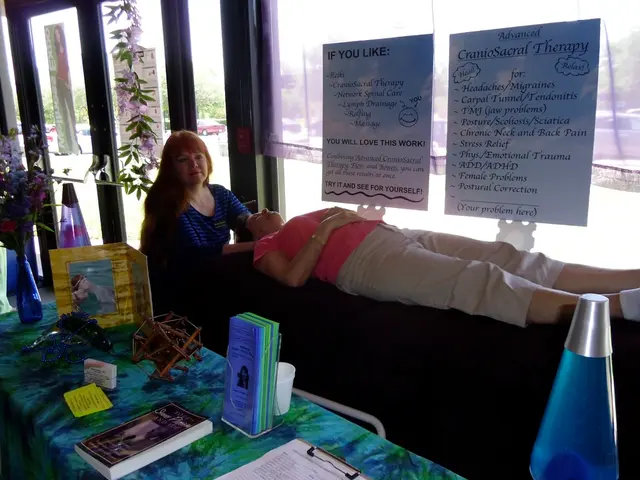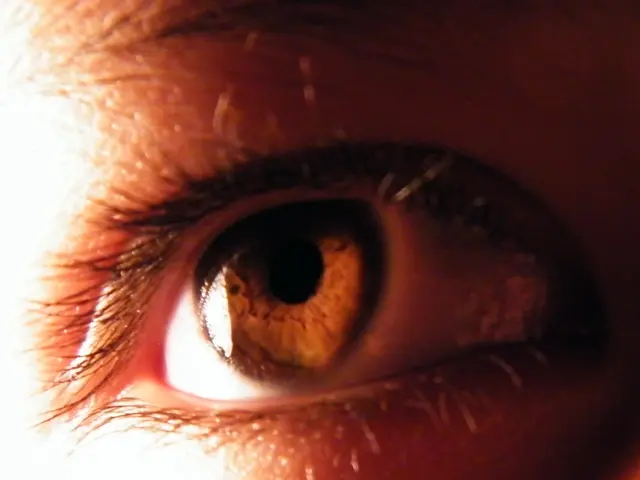Techniques for Minimizing Sweat: Tips for Reducing Perspiration
Primary hyperhidrosis, a condition marked by excessive sweating in specific body areas like the palms, soles, or underarms, can be managed with a variety of treatments and lifestyle changes.
Topical treatments are often the first line of defence against mild cases. Clinical-strength antiperspirants containing aluminum chloride (15–20%) can be effective, especially when applied overnight[2]. Prescription glycopyrronium cloths (2.4%) offer additional control, though they may cause side effects such as dry mouth[2].
For more severe cases, oral medications like glycopyrrolate and oxybutynin are prescribed to block sweat gland signals. These drugs are typically used for short-term relief due to side effects like dry mouth and blurred vision[2].
Botulinum toxin injections can temporarily stop sweat production in overactive nerves. Repeat treatments are necessary as the effects are temporary[3]. Iontophoresis, a therapy using low electrical currents through water to block sweat glands, is effective for hands and feet but requires repeated sessions[3].
Surgical treatments, such as Endoscopic Thoracic Sympathectomy (ETS) and Lumbar Sympathectomy, are reserved for severe or resistant cases. ETS can significantly reduce sweating but carries risks like compensatory sweating[1]. Lumbar Sympathectomy is used for plantar hyperhidrosis[1].
Home remedies and lifestyle changes can also help manage symptoms. Dietary adjustments, such as avoiding spicy food, caffeine, and alcohol, which are known to trigger sweating, can be beneficial[4]. Wearing breathable fabrics like cotton, bamboo, or merino wool can help moisture escape[2][4].
Home remedies include applying apple cider vinegar to affected areas or drinking it diluted in water to help reduce sweat production[4]. Baking soda and cornstarch, mixed into a paste, can absorb moisture and reduce odor[4]. Sage tea, drunk regularly, takes advantage of its natural antiperspirant properties[4].
Lifestyle modifications, such as practicing stress-reducing techniques like box breathing or meditation, can help manage anxiety-related sweating[2]. Rotating footwear and using moisture-wicking socks can curb plantar sweat[2]. Socks should be washed between uses to prevent bacteria growth.
Hyperhidrosis affects around 3% of the United States population[5]. Iontophoresis, Botox injections, anticholinergic medication, and surgery are options for severe or resistant hyperhidrosis. Antiperspirant can be applied to the feet before bed and washed off in the morning as a home remedy for excessive sweating. Shoes should be allowed to dry completely before each use.
It is important to note that hyperhidrosis can be a sign of heart disease, and anyone who experiences a sudden onset of excessive sweating should receive medical attention[6]. Hyperhidrosis has two types: primary and secondary. Secondary hyperhidrosis results from a medical condition or medication[7]. Depression and anxiety may be associated with hyperhidrosis, as shown in a 2016 study[8]. Bromhidrosis, a related condition involving excessive body odor due to bacteria breaking down sweat, may also occur[8].
Anyone with excessive sweating should make an appointment with a doctor for a possible referral to a dermatologist[7]. Shoes made of natural materials that allow proper ventilation can help reduce sweat[9]. Removing shoes when possible can also help control excessive sweating[9]. People might try wearing sandals when possible to reduce excessive sweating[9].
References: [1] Mayo Clinic. (2021). Hyperhidrosis. Retrieved from https://www.mayoclinic.org/diseases-conditions/hyperhidrosis/symptoms-causes/syc-20376639 [2] American Academy of Dermatology. (2021). Hyperhidrosis. Retrieved from https://www.aad.org/public/diseases/a-z/hyperhidrosis-treatment [3] National Institute of Arthritis and Musculoskeletal and Skin Diseases. (2021). Hyperhidrosis. Retrieved from https://www.niams.nih.gov/health-topics/hyperhidrosis [4] Healthline. (2021). Home Remedies for Hyperhidrosis. Retrieved from https://www.healthline.com/health/hyperhidrosis/home-remedies [5] National Institute of Diabetes and Digestive and Kidney Diseases. (2021). Hyperhidrosis. Retrieved from https://www.niddk.nih.gov/health-information/skin-and-connective-tissues/hyperhidrosis [6] Mayo Clinic. (2021). Hyperhidrosis: Causes. Retrieved from https://www.mayoclinic.org/diseases-conditions/hyperhidrosis/symptoms-causes/syc-20376639 [7] American Academy of Dermatology. (2021). Types of Hyperhidrosis. Retrieved from https://www.aad.org/public/diseases/a-z/hyperhidrosis-types [8] PubMed. (2016). Depression and Anxiety in Patients with Primary Hyperhidrosis. Retrieved from https://pubmed.ncbi.nlm.nih.gov/27204357/ [9] Healthline. (2021). 11 Tips to Reduce Sweaty Feet. Retrieved from https://www.healthline.com/health/sweaty-feet#treatments-and-prevention
- Clinical-strength antiperspirants containing aluminum chloride (15–20%) can be used for managing primary hyperhidrosis, offering effective control for mild cases when applied overnight.
- For those who have dietary sensitivities, avoiding spicy food, caffeine, and alcohol, which are known to trigger sweating, can be a beneficial lifestyle change for managing symptoms of primary hyperhidrosis.
- In addition to topical treatments, wearing breathable fabrics like cotton, bamboo, or merino wool can help moisture escape from affected areas, providing assistance in the management of primary hyperhidrosis.
- Some home remedies, such as applying apple cider vinegar to affected areas or drinking it diluted in water, can help reduce sweat production and be considered as additional tools for managing primary hyperhidrosis.
- Sage tea, drunk regularly, is a home remedy that takes advantage of its natural antiperspirant properties, which can potentially aid in the management of primary hyperhidrosis.




